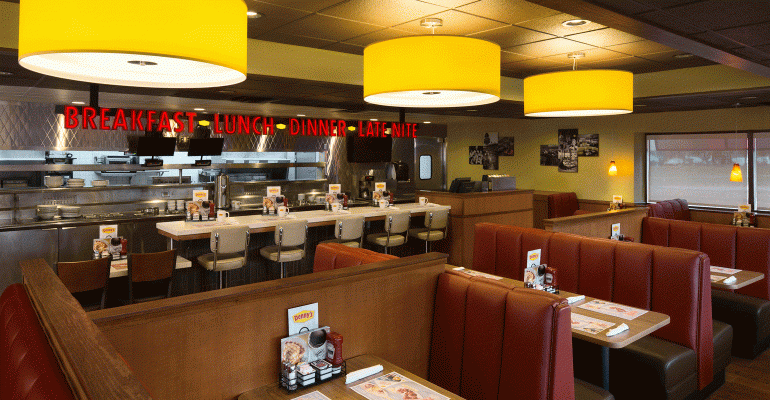Some well-established,casual-dining chains are rolling out more modern, fast-casual concepts to try to attract younger diners.They include Cracker Barrel, Tony Roma’s, Hooters and Denny’s.
These older chains want to capture market share in the hot fast-casual sector.After all, millennials dine out or get takeout five times a week, according to a study by Bankrate.com. That’s compared with just 2.5 times for boomers.
Since these chains have decades of experience in the restaurant business, spinning off a fast-casual concept to help revitalize their brand may be a natural progression.
“A lot of the casual-dining concepts are getting long in the tooth, so you’ve got a perfect recipe,” says James Cook, Americas director of retail research with real estate services firm JLL.“Some of these older concepts really want a reinvention.”
Cook says the fast-casual sector has captured a big slice of restaurant growth for awhile now.
“If you were to ask where we are in the fast-casual boom, I’d say more than halfway through,” he notes. But that doesn’t mean there isn’t room for newconcepts to compete.
Instead of making drastic changes to their existing brands and confusing customers, restaurants like Denny’sand Cracker Barrelopted to spin off separate fast-casual restaurants and most are building out new units.This way they can appeal to a younger demographic and not pushawaycustomers of their core brand.
“I can see the conversation inside any organization and millennials being one of the legs of the stool for justification of this kind of move,” says Minneapolis branding expert Aaron Keller, co-founder of Capsule. But he says there’s more in play with this strategy.
“Older brands are harder to move and change. It’s harder to change perception that’s already set in a particular brand, especiallyin the area of restaurants,” Keller says. “Not only do you have to change it for a new audience, but you also have to worry about what does that mean for your existing audience and are you going to alienate them.”
Keller adds that it’stypically cheaper to launch a new concept than “dramatically change the associations” with the existing brand.
Take Denny’s, which created its fast-casual chain The Den with 17 locations so far. With its hip décor, it’s aimed at millennials and was initially created for college campuses. Now franchisees are opening off-campus restaurants.
“Denny’s has got all of this meaning packed into it,” Keller says. “Because you have meaning, it’s going to cost millions, perhaps even billions of dollars, to change out all of the restaurant locations. How they communicate, how the staff works. It’s a gargantuan amount of change vs. starting something fresh and new.”
Keller says once a new concept is created, they must design the experience and then scale it.
“Those are the big three,” he says. “It’s all about the experience as they’re entering what’s becoming a very crowded space. How are they going to be different, interesting? Just to do a fast casual is not going to do it. There has to be some reason, some emotional connection for the customer… And then they have to have the patience for it to grow. It isn’t instant. And it likely won’t be for a very long time.”
Cracker Barrel launched a fast-casual biscuit restaurant called Holler & Dash, which looks nothing like Cracker Barrel. There aren’t rocking chairs on the porches or board games, but instead it’s modern with exposed brick and industrial lighting.
The Tony Roma’s steakhouse chain launched TR Fire Grill as a modern spin-off, and Hooters introduced a fast-casual chain called Hoots in Chicago last year.
These new concepts have smaller footprints than the casual dining establishments. For example, Holler & Dash is testing sizes ranging fromabout 2,000 sq. ft. to 3,800 sq. ft.
“They’re smaller than casual dining so you’re spending less on real estate,” Cook says. “You’ve got counter service, so there’s no wait staff.”
Dining areas and kitchens are smaller. It might cost more per sq. ft. for prime locations, but it’s less square footage, he adds.
Most of these new concepts want to be located on urban or high-traffic suburban sites.
“Right now, existing brands trying to roll out a fast-casual concept are in the testing phase,” Cook says. “Everybody’s experimenting with new growth concepts just to find the next growth engine. So when you’re testing, you really want to find a good site. You know the traffic is there. You know the diners are there. You’re really just working on refining the concept. If that’s an urban setting, it needs to be clearly on a first floor with high foot traffic. If it’s in a suburban setting, you probably want an end cap or someplace with good traffic counts.”
The restaurant business is extremely competitive, Cook adds.
“We have a lot more new restaurant concepts opening than what’s sustainable in that there will always be some that will fail,” he says. “That’s the nature of the restaurant industry.”
That’s something that retail landlords keep in mind as well. According to Alan Zell, president of Phoenix-based retail property management and leasing firm ZELL Commercial Real Estate Services, with spin-off concepts “the advantage is you’ve got an experienced restaurant operator—in their parent company—but it is a trial balloon.”
“There’s always the chance that the location may not make it, or that concept may not make it, so there’s a risk factor for the landlord to get involved with that type of deal, to spend leasehold improvement dollars... So I think it has its positives and some drawbacks because of the trial balloon aspect.”

